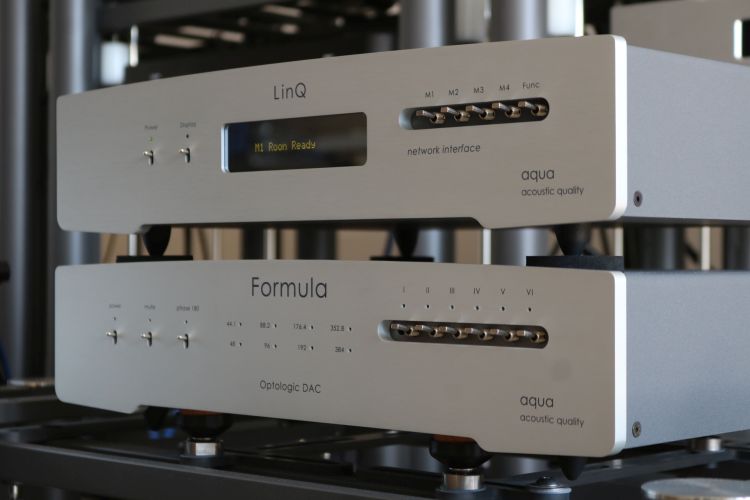
Review sample supplied by Hexagon Audio
Retail prices in the NL including 21% VAT:
LinQ including one UPnP/DLNA or ROON module: 5.680 euro
Extra module: 1.280 euro
AQlink I2S cable with Ethercon (for La Scala and Formula DAC): 365 euro
AQlink I2S cable with RJ45 (for La Voce DAC): 335 euro
Technical
The Aqua LinQ is a Network Interface that was created following the company’s philosophy of providing only proprietary solutions in a fully modular setup. Further, the LinQ offers four slots that can be used for any combination of interface boards that plug into a connector on the base platform of the device. Available right now are the Roon Ready (RAAT) module and the UPnP DLNA streaming module and these have been fitted to my review sample. Each module’s communication line with the network is galvanically isolated, each module has its own dedicated power supply and in addition, this architecture allows future updates to be fitted very easily. Aqua does not use off-the-shelf solutions and that policy extends even to the fully-floating hybrid 2-stage Network LAN switch module. In addition to being fit for purpose, this proprietary network switch offers additional isolation and is said to be an important aspect of the LinQ’s performance.
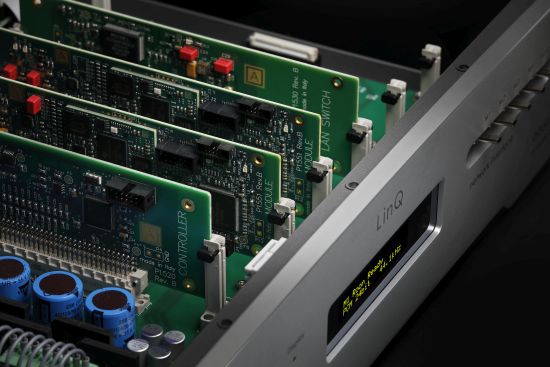
Aqua also makes a point of having made a very conscious decision not to use USB for the LinQ in their quest to achieve the best sound. The output is on AQlink, the aqua I2S proprietary connection. This way, the extra USB interface is skipped to avoid any losses in sound quality. Furthermore, proprietary circuits have been developed in the output FPGA, to implement S/PDIF, AES/EBU, and dual-AES outputs. S/PDIF is available on cinch and BNC and all outputs, AQlink included, can be used simultaneously. Depending on the selected output the maximum resolution is PCM 32 bit 384kHz / DSD128.
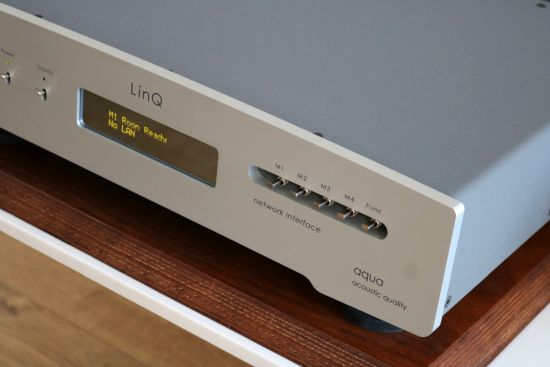
First use
At the time of review, no manual was available but as it turned out the LinQ works super-intuitively. The unit starts up very quickly and self-initializes without the need to select anything except for the desired Network Protocol, call it the “input”. Some network players have proven to be quite finicky in use and some won’t connect to the network unless they have been booted in a particular mode or have been connected in a certain order. Not so the LinQ. The unit works flawlessly irrespective of starting up with a network cable connected or said cable attached after the unit was already on. Attach it and within seconds the unit connects and is ready to go. It’s exactly as you would expect a network device to work but sadly is not always the reality.
Roon Certification
Cristian Anelli of Aqua tells me that the Roon RAAT program procedure was started in 2019 but, so far, the LinQ has not yet received the Certified Status. This means that the “Uncertified” message may appear in the Roon software. In light of the recent Roon announcement of no longer allowing the enabling of non-certified devices it is good to note that, in the case of the LinQ, this is of no further consequence. Thanks to the proprietary firmware developed in-house for the LinQ, Aqua has been able to implement a custom Roon Endpoint Bridge which does not require adherence to the certification program.
Update 05-11-2020
The LinQ will not be Roon-certified and, thus, the Roon module will no longer be available. Fortunately, in addition to the UPnP/DLNA module, there is now the HQPlayer module that allows using Roon and all of its benefits along with even better sound than was possible using the now-discontinued RoonReady module. For more info, see part 2 of the LinQ review.
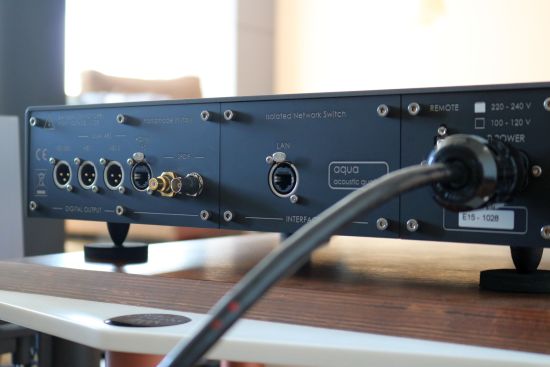
Make sure not to use any Aqua component directly on another Aqua component or other delicate surfaces. My go-to solution is to use Neoprene pads made by Artesania.
Running In
The LinQ is said to be fully on song after about 100 hours of use. Even so, of course, I listened to it right after having connected it and all I can say is that it impressed me right from the start. At the moment of writing, the unit has been in use for about two weeks and has easily had over 100 hours of use but I can’t say that it changed noticeably. Your mileage may vary but to me, it sounded superb right from the start and it still sounds superb after two weeks of use.

Outputs
All the LinQ’s outputs can be used simultaneously and having done this while comparing them I can report that AES/EBU, coax, and BNC all sound very, very similar, and what little discernible difference can be heard can likely be attributed to the cables that were used. Although the difference should theoretically be audible throughout the spectrum, they are easiest to hear in the upper bass where I can differentiate between coax on Belden RG59 and AES/EBU on Mogami neglex 3080 by the former sounding slightly fuller and the latter sounding slightly more nimble and articulate.
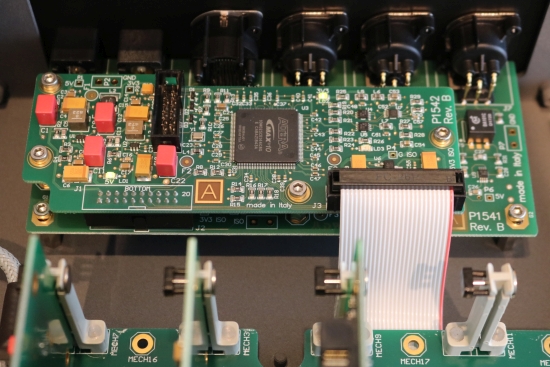
The FPGA-controlled output board
For digital connections in general, I have long preferred coaxial S/PDIF (using Belden RG59 cable) over AES/EBU but, as always, the quality of the connection much depends on the cables that are used as well as the interface implementation on both ends. With my current CH system, as well as the Aqua components, I prefer AES/EBU (using Mogami neglex 3080 cable) for its slightly more precise sound and it is this connection that I used predominantly with the CH Precision C1 DAC for the purpose of this review. As it happens due to the lack of an official standard, many manufacturers choose their own interface for I2S connections. Aqua has opted for RJ45 (the network cable connector) and CH Precision has its own proprietary digital interface which is not compatible with AQlink (or any I2S connection scheme for that matter) which is why I used AES/EBU. Where the Formula xHD DAC was used, AQlink was the preferred method of connection. In the AQlink section further below you can read about the audible differences between the various outputs.
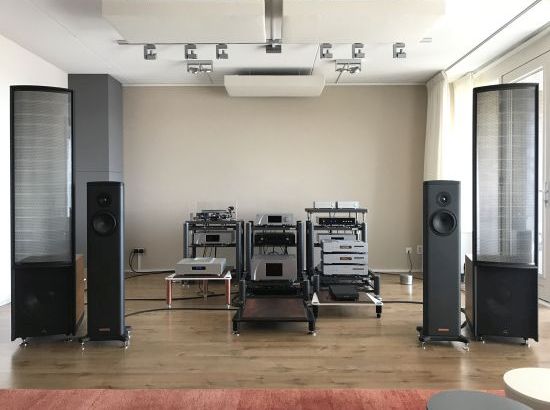
Eagle-eyed readers will discern the La Diva CD transport on top of the Aqua stack. For the purpose of this review, I opted to focus only on the LinQ. In another review, I will elaborate on comparisons between the CD transport and the LinQ network transport.
Listening
The LinQ review sample contains both Roon and UPnP modules but given the overwhelming popularity of the former, I will start my assessments with the Antipodes CX server in Roon mode and will focus on this for the most part.
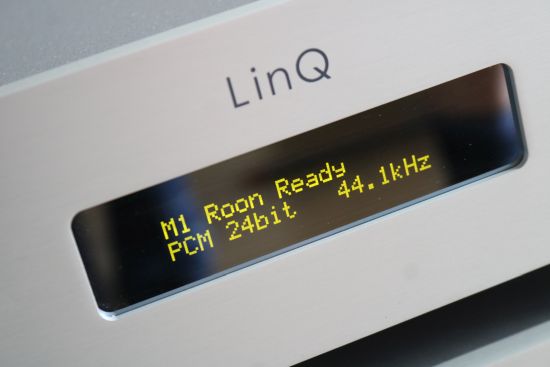
Starting with the obvious pairing made in heaven, the LinQ was first used with the Aqua Formula xHD DAC, its output relayed very transparently via the Audio GD Master 1 preamp to the CH Precision A1.5 power amplifier that was used with either Martin Logan ESL15A or Magico S1 MkII speakers. All power cables are Belden with Bals schuko and Oyaide C-004 IEC connectors.
Right from the start, the LinQ presents itself as a super-transparent interface. The unit simply never imposes itself onto the signal and what comes out is nothing but the pure and natural music signal, 100% unaltered.
If an audio component has no character of its own, how do you describe it? I will start by listing what it does not do. Firstly, the LinQ performs no resampling or processing of any kind, which I think is always the best you can do in the digital domain. Further, it never puts a restraint on the speed, PRaT or dynamics. It is 100% transparent but never clinical, mechanical, or synthetic and it does not change the timbre. Finally, it does not alter the dimensional cues that are embedded in the source signal meaning that small-scale and intimate recordings or grande, room-filling recordings sound just as they should. But in reading this back to myself, I feel that all this does not really describe just how fabulous the LinQ really is.
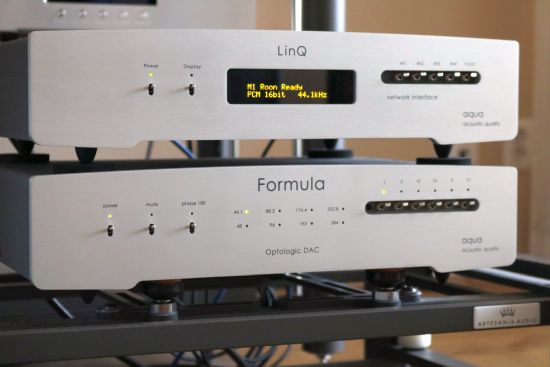
Comparisons
In order to more clearly expose the LinQ’s greatness, let’s perform some comparisons, starting with perhaps the most illustrative one: the CH Precision C1 DAC. Besides functioning as a DAC, the C1 also offers modularity similar to that of the LinQ and it, too, contains a Roon Ready module. This makes it possible to compare the Roon performance from the same source either via the LinQ and its AES/EBU output or directly into the C1’s Roon Ready module. Normally, I use a direct Pink Faun Digital Link ethernet connection between the Antipodes CX music server but in order to create equal circumstances, I connected all devices using the same OEM CAT6 ethernet cable types directly to the same network switch, which is a very standard Cisco Linksys model. This way, the CX feeds the C1 and the LinQ via the exact same route.
CH Precision C1
In earlier comparisons with USB connections the C1’s Roon Ready network module always provided the best result. To be honest, I fully anticipated this method to also have advantages over, what is in essence, a detour via the LinQ and an AES/EBU interface on two ends. Imagine my surprise when I found that the LinQ’s output sounded spectacularly good. The LinQ’s presentation is a little different from the C1 board’s and I’m not sure which is objectively better. What I can say is that the LinQ’s slightly crispier presentation was highly seductive.
As it turned out, my preference for one or the other mostly depended on which connection I just listened to for a while. On the one hand, the C1’s direct connection via the Roon Ready module has a slightly smoother and more relaxed feel to it. On the other hand, the LinQ counters with a relatively slightly slenderer but also tighter and more expressive delivery. Coming from the C1’s Roon Ready module, the LinQ sounds a little more concrete and upfront. Vice versa, the C1 sounds a little smoother. Depending on system synergy and personal taste, it could swing either way. But even if you could regard the outcome at this stage as a tie that is still a remarkable achievement for the LinQ.
Given that the C1’s Roon Ready module is internally connected via I2S, one would assume that it has an inherent advantage over the LinQ which outputs via the AES/EBU interface where the clock has to be retrieved from the input stream. Whereas I2S over AQlink to the Formula xHD DAC did indeed enable a deeper soundstage with better 3D layering (more details below), I found the differences in this field via the C1 to be vanishingly small.
I would say that the only possible conclusion for the LinQ’s more articulate and concrete delivery in spite of a detour via another digital interface format is that it must be the result of the great attention paid to the network input and the isolation between its connections as well as a splendidly implemented FPGA output section. That, and of course the C1’s digital input section is nothing to sneeze at either.
Reassuringly, where increases in expression can often be accompanied by a decrease in the naturalness and the flow of the music, all that the LinQ seems to do is more clearly relay whatever is in the recordings. The better articulation leads to a crispier sound but it stays absolutely natural and never comes across as technical.
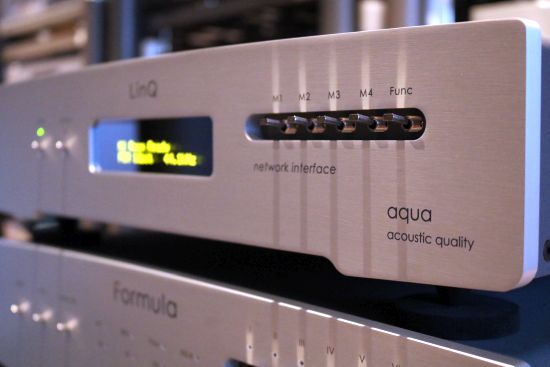
AQlink
Aqua makes a big deal of using I2S on their proprietary AQlink connection as the preferred method and this is with very good reason. Rather than the more common connection methods, I2S does not mix clock and music signals but transports them separately. The big advantage is that the receiving device does not need to extract the clock from the music signal (which can introduce jitter) but is handed the two signals as unscathed as they can be when transported over a cable.
When comparing AES/EBU to AQlink connections between the LinQ and the Formula xHD, the latter connection’s benefits are audible even when using a simple but short 1-meter generic CAT5 network cable. The benefits include a brisker rhythm, crisper transients and an increase in soundstage depth. The latter manifests itself not only as a generic deeper ambiance but also allows sounds to originate from, or disappear into, a deeper position within the soundstage. There is more movement and life in the soundstage, it’s less static. This has the very meaningful benefit of making the performance sound more enveloping and thus more involving. However, when using this generic RJ45 network cable, the bass was also slightly less forceful than with either the AES/EBU or coaxial connections. Because of this, between these cables at this point, it was a bit of a tradeoff between a clearer yet slightly leaner delivery with a more 3D presentation versus a more solid and forceful one albeit with a flatter presentation. Interestingly, an intrinsically better but longer 3-meter generic CAT6 network cable did not always work reliably which only goes to show how delicate the digital signals are. But so far I was using standard ethernet cables. What about Aqua’s very own AQlink cable?
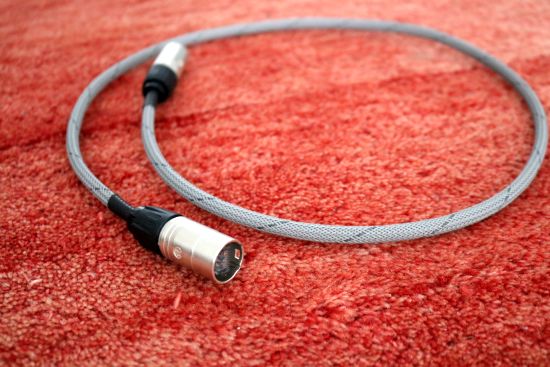
AQlink Cable
Upon changing the generic CAT5 cable for the AQlink cable the difference was astonishing and within seconds, this cable’s supremacy was established. The bass firmed up further but also became more impactful to the point where it was every bit as full and solid as the AES/EBU connection while retaining all the fluidity, 3D-soundstaging, and clarity that I noted using the standard CAT5 cable. Clearly, the generic network cable did leave a portion of the signal behind which leads to arbitrary and system-dependent benefits but with the AQlink cable, there was no question about which connection sounded best.
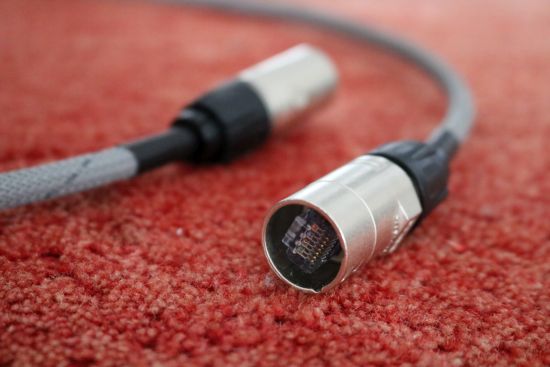
At 365 euros, the cable may not be a no-brainer but a quick look at the high-end competition shows that it is actually decently priced. Similar results might be possible using a cheaper cable but none that I have in my inventory actually did the trick. To be honest, if you can spare the extra cost, I would not think twice and just go with what Aqua has already confirmed works best and order an AQlink cable along with the LinQ.
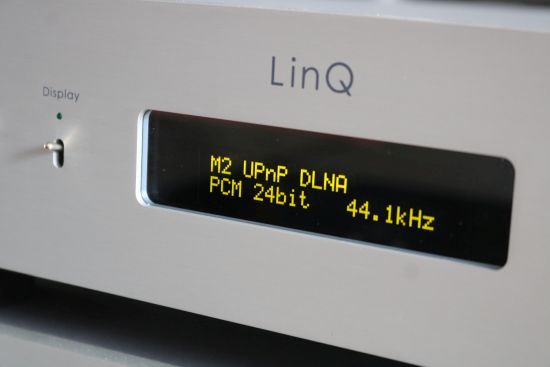
UPnP
So far, I’ve only looked at the LinQ’s performance using Roon and I’ll admit to almost having forgotten to also test its UPnP section. Inside the LinQ are two separate modules, each optimized for its specific task. A benefit of this, apart from sound quality reasons, is that you can actually send UPnP and Roon streams to the LinQ simultaneously! This makes it simple to play the same track on two systems and simply switch between them using the LinQ’s front panel switches. The signal switches instantaneously and both streams keep working flawlessly.
Just fast enough to allow me to do my work, my regular Windows tower computer is nothing special and it certainly is not audiophile. Long ago I have tried to elevate its performance as much as I could, first using special internal sound cards and particular cables, then external sound cards, USB interfaces, streaming endpoints etcetera, only to find that the AudioAanZee Ultra Flow Music Server connected to the DAC via USB surpassed it with ease. Ever since, I have not bothered using this computer except for the occasion where I reviewed the JPLAY Femto software in the Genelec 8050 computer audio system that I had at that time.
Just because the Antipodes CX server has no UPnP/DLNA server installed by default (it does function as an endpoint), I just used jRiver Media Center on the computer for a quick check, just to see if it worked. Oh, work it did, and more than that!
I had to double-check my findings as I almost could not believe it but sure enough, UPnP performed a little better. I’ll let that sink in. Yes, it was better in terms of being crispier and more resolute and just more “alive”. Roon, on the other hand, sounded fuller but also slightly less precise, a little thickened and dynamically more damped.
The LinQ keeps surprising me. First, it manages to sound just as good as the built-in, I2S-connected, CH Precision Roon Ready board, and now, apparently, now it has elevated the standard Windows computer to sound like an audiophile NAS. Does this mean that all those people claiming that the hardware should not matter as long as the bits come across actually have a point? Well yes, in an ideal world. As I vividly recall this very same Windows computer to sound ill-defined, bloated and even artificial in all earlier comparisons, I actually think that the LinQ and its network isolation play a vital part in this particular outcome.
Qobuz
A comparison using Qobuz (Studio Quality subscription) to stream music from within Roon as installed on the Antipodes CX or directly to the LinQ further confirmed the above. There is no way around it: Qobuz sounds just a bit crispier and better-focused as well as more 3D when playing directly to the LinQ using the Android Bubble UPnP app. Moreover, directly into the LinQ, it sounds much more like local playback than I remember it did when I tried it with different hardware years ago.
That leaves only the question of what causes the differences as noted. Are these caused by Roon or Antipodes?
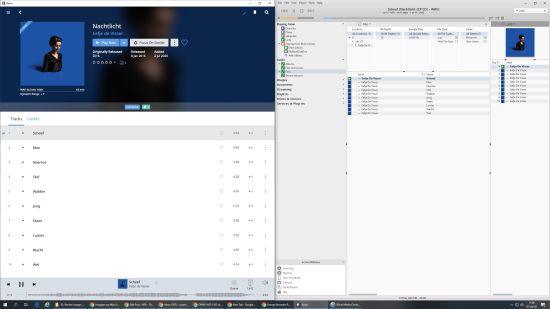
Music Server / playback application
In order to get to the bottom of the differences in presentation as noted above between Roon on the Antipodes CX and jRiver on the Windows computer, I decided that the easiest way to settle this was to disable the Roon core on the Antipodes CX and enabling it on the Windows computer. This way, both applications are running on the same computer and because the LinQ can accept both streams at the same time it was very easy to switch between the two to assess the differences.
Well, that matter was settled very quickly and in favor of UPnP via jRiver. Indeed, Roon sounded slightly less crispy and direct, less “alive” than UPnP via jRiver. That Roon was now running on entirely different hardware seemed to have made no difference at all which is another testament to the LinQ’s greatness. But, in spite of the LinQ’s immense transparency to show the essence of the music and its ability to raise the quality of upstream sources to a uniformly high level, the music server program still has a small difference on the end result.
Conclusion
The LinQ has the uncanny ability to improve the quality of upstream components but it does this while refraining from imposing any discernible character onto the proceedings. Whether using UPnP or Roon and even independently from the hardware that is used upstream, the LinQ always delivers the best possible rendition.
In my opinion, the Aqua LinQ is nothing less than a milestone product. It is the absolute best network endpoint that I have heard and I enthusiastically recommend an audition.
While 5.680 euros is not exactly chump change, the reality is that I can name several competing products that cost multiples. But also think of it this way: any money spent on the LinQ does not need to be spent on any extravagant upstream hardware.
Update
The Roon module is no longer available for the LinQ. Instead, Aqua offers the HQ Player Core + NAA module. Instead of Roon RAAT, the module uses the NAA protocol, which is compatible with Roon servers.

Try out Roon for yourself
Videos on the Hifi-Advice YouTube Channel
How Sooloos became Roon
HFA Front Page
External Links
Distributor for the NL/Belgium: Hexagon Audio
Manufacturer’s website: aquahifi.com
Read Also
Aqua LinQ part 2 (HQPlayer NAA Renderer module)
Aqua LinQ part 3 (Core + NAA module, enabling Plug&Play Roon compatibility)
Aqua Formula xHD DAC
Aqua Formula xHD v2 Output Board upgrade
Aqua La Scala mkII DAC
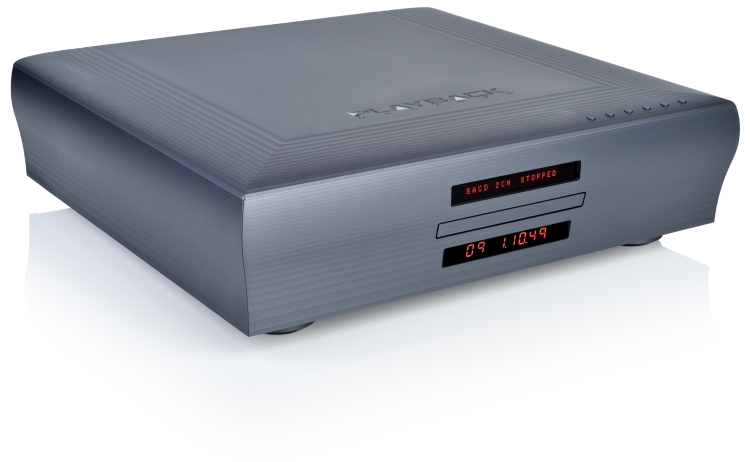







Hi Christiaan,
excellent review as always.
Looking forward to your comparison Aqua Diva vs Aqua Linq.
Please give the Linq a chance and do the comparison with UPnP and not with Roon.
Thanks
No worries:-) The comparisons that I have done between La Diva and music server so far were based on Roon and as I now know UPnP sounds better I will need to reassess my findings. Alas, the review samples have moved on but I expect them back probably in September and that’s when I will do the follow-up review.
I hope that Hexagon Audio will provide this comparison as well at the Dutch Audio Event.
He may well do indeed, but just in case, I will forward the request:-)
Hi Matt, the second installment of the LinQ will be published soon. In it, I will discuss the various streaming options, including HQPlayer. Alas, I have not been able to obtain a Diva sample for direct comparison. However, I still intend on making that comparison in a next installment.
Hi Christian, I’ve been waiting for a review on the Linq and glad you were the one to write it. What’s the Linq like compared to the Antipodes CX &EX combination? I have an Auralic G2 is wondering whether the Linq or Antipodes is an upgrade. Ashdod has my eye on the Innous Zenith Mark II SE but don’t think you’ve reviewed any of these yet.
Alas, I cannot comment on the Auralic of the Innuous but I can indeed tell you about the LinQ versus Antipodes. The Antipodes EX and CX only offer USB and the LinQ does not offer USB and therefore I cannot make a direct comparison but I can confirm that the LinQ is the most articulate, fast, neutral, pure and realistic sounding endpoint that I have heard. In as far as a comparison between the Antipodes CX (via USB or Network) and the LinQ (via I2S or AES/EBU) can be considered meaningful using two different interface formats, the aforementioned still remains true. And even when comparing the LinQ to the CH C1’s Roon board, the former still sounds more exciting to me. However, it should be noted that the LinQ is extremely neutral and transparent and is highly precise. Not everyone wants the whole truth and nothing but the truth from their system. The Antipodes servers, for example, tend to sound fuller and more sonorous and depending on your personal preferences could make a better match. One great aspect about the Antipodes servers is that they also allow to be paired with Squeezebox, Sonos and MPD systems, among others. So far, to me, UPnP with the LinQ sounds the best of all but depending on the server software, the UPnP/DLNA user interface can offer a sparse experience. Squeezelite with iPeng on an iPad offers a pretty good user experience as well as good sound. The best interface I used, outside of Roon of course, is jRiver Media Center with the JRemote.
Hi John, I thought you might be interested to hear that Antipodes Audio is about to launch an entirely new range of products which should appear on the official website very soon. At this point, no promise could be made for a review sample just yet but if I can, I will try and make direct comparisons with the LinQ (if I can get hold of that unit in the same timeframe).
Hi Christian great review.
I have a LinQ with Roon only module on its way so I am very excited. This will be a replacement to my current Antipodes EX as I use today as a player. (The roon core is on the Innuos zen mini mk3)
Hopefully this will be a great upgrade, at least this is what my dealer say. Did not find any information what other network tweaks you have done. Like audiophile switch or optical. Perhaps this will be of less importance now as the LinQ has a switch already built inside.
Hi Magnus, ATM, I don’t use any filtration or special switches, but indeed, it seems that the LinQ also cares less about this. Let us know how you get on once you receive it. I think you’ll be impressed with the LinQ.
Christiaan, I have now the linQ playing in my system for a few days. The SQ seems to improve with burn in as time goes by. I was thinking about how the server part will influence. Have you had the chance to try various servers with it. I understand you have experience with both servers from 432EVO and Aan Zee servers and also Antipodes. My hunch is as always that server part is important. Regards Magnus
Hi Magnus, in all matters audio, it’s always a sum of the parts. Having used various servers I can confirm that indeed they, too, have an influence on the sound and depending on the connected equipment and circumstances their influence can be considerable. With the LinQ, however, I found that the differences between server hardware were relatively small. Smaller, indeed, than those between server programs (for instance Roon versus UPnP) and digital interlinks.
Thank you Christiaan, Yes in “normal” cases all matters but with linq in the chain it seems so far that server quality matters less.
I am using La Diva with La Scala Optologic DAC. I am wondering what will be your result from comparing La Diva with Linq.
I wonder about this, too! Alas, due to time constraints, my time to compare them was limited but a follow-up review will be done as soon as I can get the two units back in again.
Hi Patrick, alas, I have not been able to obtain a Diva sample for direct comparison for the second LinQ review. However, I still intend on making that comparison in a later review.
Christain: Nicely done !
peter jasz
Thanks, Peter!
I understand the the UPnP / DLNA also supports the OpenHome protocol. Have you tried testing it?
OpenHome is used by Linn and their DS streamers. My only experience with the format is with the Klimax DS/0 and DS/1.
Do note that UPnP and OpenHome are not fully compatible. OpenHome renderers cannot be controlled by standard UPnP/DLNA control points and standard UPnP/DLNA renderers cannot be controlled by OpenHome control points but there are some controller applications that contain both types of control point.
Thanks but that is not what I am asking. Based on comments I saw online, the Aqua LinQ supports the OpenHome protocol. Have you tried an OpenHome app (Kazoo, Lumin, BubbleUPnP, etc..) to test it?
Thanks for the great review. Is there any needs to use external ethernet switch for the LinQ even if LinQ offers high quality built in LAN switch?
Hi Patrick, well, the LinQ’s switch only has a single output so its use is limited to itself. You’d still want to use a switch if you are connecting a server or other equipment.
Thanks for the answer. What kind of server is the best to use with LinQ? At the moment i am using external HDD connected to the macbook where i have installed Audirvana which is operating LinQ through UPnP DLNA.
To my ears, the LinQ currently sounds best with UPnP. There are many possible alternatives but this is too wide a topic for me to come up with a singular answer. That said, rest assured that the LinQ sounds fantastic even with the most mundane server solution. Unless you want to take your setup in any particular direction, you can leave it as is.
Hi Christian,
I have had a Bryston BDP-2 for several years that I would like to replace with something more current, and I have examined everything, but without getting to the ”delivery”. One idea was to direct me to two items you own: Aqua LinQ + Formula. In this case, in addition to the streamer, I would also replace my Bricasti M1se. My doubt is that I have not yet framed the LinQ well, I mean that I am not sure if it can be considered a pure streamer and with the same functions and ”role” as (for example) an Innuos Statement, an Auralic Aries G2. 1 or a Lumin U1. I have seen that Aqua offers different modules depending on the use you want to make, I only use files locally (from a NAS), and for the moment I am not interested in Roon. I was confused by some posts I read on the net, in which they wrote that LinQ is not exactly a classic streamer. I was asking to you because you own it and are you familiar with Aqua products (by the way, from Bricasti M1 to Formula xHD, is it a ” traumatic ” step that could destabilize my system?). If you have other options to suggest I will gladly read them, even if I am avoiding servers that rely on Roon, preferring those who use their own software; i see that besides LinQ, you own other servers like Antipodes and Grimm, but both are not distributed here in Italy.
If that helps the rest of my system is a Boulder 1100 + 1160 and PMC BB5i monitor.
Many Thanks
Roberto
Hi Roberto, the LinQ is as much a “pure” streamer as the BDP-2 or the others you mention. The only difference is that the BDP-2 and most other streamers offer software-based functionality (and often limited by this) while the LinQ can be configured as you like during purchase with hardware modules which also allows it to be changed or upgraded later. If you only use local files on a NAS (presumably using UPnP), then any of the streamers you mention will do the job. What’s more, if you don’t need or want Roon, that’s an extra compelling argument for going with the LinQ. While I can see why Roon functionality via HQPlayer can seem complicated, its UPnP sound quality is the best I’ve heard and it works flawlessly with absolutely no skill required. The LinQ may appear to be unusual but it is not as complex as it may appear, and most importantly, it is still the best network player that I know of.
Regarding Bricasti M1 vs Aqua Formula xHD, well, that is mostly a matter of system synergy and personal taste. It depends on what you expect or want. Do you want to offset the balance or do you want everything to stay the same? Certain aspects that you are looking at improving? Honestly, the M1 is also a great DAC and at a good price and the Formula xHD will not so much provide deeper levels of detail or enhance the resolution. What it will do, is present the music with more crispiness and realism as it gets rid of what I call the “filtering effect”. The thing to keep in mind is that in getting closer to reality, the Formula xHD has less of the creaminess and smooth forgiving quality that Bricasti has. This is not to say that the Aqua is overly clean or “unmusical”. Compared to many other DAC’s, the Aqua strikes a perfect balance between resolution and musicality as it still has deep tonal rendering, great musical flow, and very good liquidity. It’s just not laid on top as with the Bricasti.
But why go all-in right away? I would suggest first trying the LinQ and hearing it for yourself with the Bricasti. After that, you can see if adding the Formula is the right way for you to go. I mean, apart from the benefit of being able to use I2S, there is no rule that a system or even its digital front end must be comprised of a single brand. Oh, one nice option you have, if you don’t mind involving tubes, is the La Scala DAC. It may not offer all of the Formula’s resolution and linearity but it offers something special in return.
Hi Christiaan, the idea of switching to Formula xHD, in addition to the curiosity to try a product of which I have always read excellent opinions, was precisely to exploit the natural synergy it will have with LinQ (and not only thanks to the proprietary I2S connection) . Having to stay with the Bricasti, the combination with the LinQ I find it less intriguing (but it is certainly my mental limitation), and I would be more directed towards objects like the Innuos Statement (of which the new updated power supply), of course the price is far higher than the Aqua. Or, especially if I don’t get a good rating for my Bricasti M1, I might think (assuming it makes sense) to hold two alternate dacs, although I don’t know if the LinQ can handle two outputs simultaneously (as my Bryston BDP can do); if this is possible, I could configure it like this: LinQ via I2S to Formula and LinQ via AES-EBU to Bricasti, of course the prices increase … 🙂
I understand:-) I have not auditioned any Innuos product yet so, alas, cannot comment on that.
Forget it: I was rereading your review, and I saw that you had reported that all LinQ output can be used simultaneously.
Indeed, all outputs are active simultaneously. And you can even use AES1 of the Dual AES outputs for sample rates below 96kHz.
Christiaan i advice you to remove LAN adapter together with the internal short piece of LAN cable and connect your incoming ethernet cable straight to the motherboard of LinQ. Perhaps you did it already and you know that the sound improvement is incredible in that case.
Hi Patrick, I’ve not tried it but I’m sure it will make a difference. Whether better or not may be a personal matter and it may also be situation-dependent.
The final effect can also depends on the LAN cable that is used in this situation. In my case i am using JCAT Signature Gold and removing this “bottleneck” in LinQ makes really a huge difference in terms of clarity and resolution.
Hi Christian
Thanks for great reviews which contributed in no small part to my getting a Scala DAC. I was not expecting to be blown away, and I was, to the point that I’m getting a Linq. My understanding re. the I2S connection is that as long as I’m connecting two Aqua devices, any regular RJ45 will do the job?
Thanks for the nice feedback! Indeed, any decent network cable with RJ45 connectors will work. However, you can observe differences in sound depending on which cable you use. I have described this in one of my Aqua reviews, but I forget which one that was. I do recall my conclusion, though, which was that the AQLink cables sounded best.
Thanks Christian for the quick answer, much appreciated. Yes I will get the Aqua cable when I find one that’s not 480 euros, the price has gone up since you reviewed it. In the meantime, I wanted to make sure I could use something.
And sorry for removing an A from your first name Christiaan It’s back now. 🙂
No probs, people call me Christian all the time:-)
Hi Christiaan ! congratulations for your web and job !
I have problems with my innuos because I use Roon and dsp and it lacks power.
My Dac is an Aqua La Scala mkII and I’m thinking in two options:
_ Aqua Linq with a server (Roon core) like Roon nucleus
_ Antipodes k21. (I cannot afford the k50)
What do you think and what option could you recommend me please?
And my second question: Have you achieved better results with Qobuz than with local files from a hard drive?
Thank you very much
Best regards
Javier
Hi Javier, the decision will depend on your personal preferences. AQlink (I2S) is a nice bonus of using two Aqua components. But even with standard connections, there is a difference in character that will be more decisive. With the LinQ, you’ll get the crispest, most articulate sound, and with the Antipodes, you’ll get a smooth, lush, and liquid sound. K21 will give you a lot of what K50 offers.
I find that Qobuz usually sounds so good that I no longer worry about the source, either when listening casually, or making reviews. Sometimes, Qobuz can sound better than a CD rip, for instance with modern recordings where the export from the music workstation is a shorter path than the detour via mastering for CD, the actual pressing of the CD, and the Ripping process. Other times, local copies can sound better, for instance when original versions of albums are less processed and compressed while streaming services always offer the latest remastered releases.